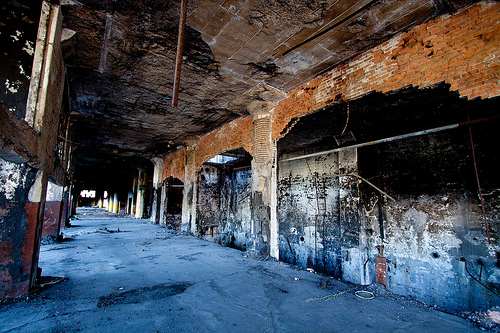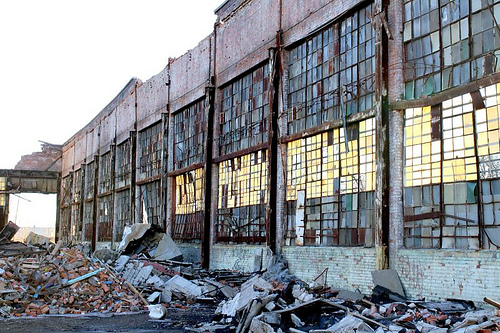 Photo: BB and HHThis essay originally appeared in Rustwire.
Photo: BB and HHThis essay originally appeared in Rustwire.
Living in the Rust Belt, one becomes accustomed to things that many people would find shocking. Examples: Not long ago, I saw the façade of an abandoned building fall out of itself on fire and into the street. Firemen and neighbors gathered around to look. Nobody was surprised, really. It was more a communal experience than anything. Not a few weeks later, I went for a jog and came upon another building that had been reduced to a skeleton of twisted metal that had its insides sunken in. It was quiet. The smell was of a cooled burning.
Such scenes of destruction are prevalent in post-industrial cities like Cleveland, where I live. The commonness of vacancy, disassembly, and decay can be damn near Mad Max-ian. Don’t believe me? Spend a day in Detroit. Chunks of the city feel like real-life versions of the fictional setting in Cormac McCarthy’s novel The Road. An excerpt:
On the far side of the river valley the road passed through a stark black burn. Charred and limbless trunks of trees stretching away on every side. Ash moving over the road and the sagging hands of blind wire strung from the blackened lightpoles whining thinly in the wind. A burned house in a clearing and beyond that a reach of meadowlands stark and gray and a raw red mudbank where a roadworks lay abandoned. Farther along were billboards advertising motels. Everything as it once had been save faded and weathered.
Depressing, eh?
I don’t think so. Detroit to me is a special place. In fact I don’t feel the modern ruins littering the Rust Belt landscape are a negative. Rather, I believe that Cleveland and Detroit and other cities that have borne the brunt of a broken system are also home to something else: a possibility tied the ubiquity of so many vacant and crumbled things.
After all, “every act of creation is first an act of destruction.” Picasso said that. Picasso could have painted Detroit the way it is. In Guernica, he kind of did.
Destruction and decay get a bad rap in America. Cities have died and shrunk since the onset of civilization. Cities are not immune to death. Yet here, we treat urban decline like leprosy, as it goes against the grain of the American philosophy of growth, expansion, and construction.
Being broken is the key to transformation. The future of America is about re-imagining the geographies of its past. Anton Chekhov once said, “Don’t tell me the moon is shining; show me the glint of light on broken glass.”
 Photo: Tito PerezIt’s not easy to perceive value in ruin. Self-flagellating is common in these parts — it can be toxic. We are fucked here. We are cities with tubes and prosthetics in an arena where Manhattan and Silicon Valley dunk on everything. But what we really need to be doing is winking at each other in self-confidence.
Photo: Tito PerezIt’s not easy to perceive value in ruin. Self-flagellating is common in these parts — it can be toxic. We are fucked here. We are cities with tubes and prosthetics in an arena where Manhattan and Silicon Valley dunk on everything. But what we really need to be doing is winking at each other in self-confidence.
Why?
Because the America of Times Square and Texas-style growth is an illusion that is barely keeping itself from falling apart, whereas the Rust Belt has been able to stare at the pieces of a broken paradigm for some time now.
So is the future really here? I think so. So does Alex Krieger, a professor at the Harvard Graduate School of Design. From a Fortune article:
“The notion of a walled city, a contained city — that’s an 18th-century idea,” [Krieger said]. And where will the new ideas for the 21st century emerge? From older, decaying cities, Krieger believes, such as New Orleans, St. Louis, Cleveland, Newark, and especially Detroit — cities that have become, at least in part, “kind of empty containers.”
The question becomes, then: What can spark a perceptual change not only in the Rust Belt but in the American psyche? A change from the avoidance of failure to the need for it — from the hate of ruins to the possibility inherent in them?
Enter ruin porn.
Ruin porn, an artistic movement centered on photographing the scenes of post-industrial decay, has been called condescending to Rust Belters. It has been called a necessary evil. It has been called masturbatory art. I call it a tool for changing perception. Let me explain.
 Photo: Tito PerezRuin porn has “outed” urban decay. It did this through the simple act of caring to look. Before that, ruins in America really were a pornographic experience: a scene from the underbelly, of and for the poor, the scrags. It was a private affair dirtied through the interaction between the filth of the aesthetic and the guilt of the observer for having to live with it. But by outing and framing it, and by capturing the inherent beauty in broken things, ruin porn exposed the failure and decay, thus clearing the secrecy, the shame, and leaving room to see less emptiness and more space.
Photo: Tito PerezRuin porn has “outed” urban decay. It did this through the simple act of caring to look. Before that, ruins in America really were a pornographic experience: a scene from the underbelly, of and for the poor, the scrags. It was a private affair dirtied through the interaction between the filth of the aesthetic and the guilt of the observer for having to live with it. But by outing and framing it, and by capturing the inherent beauty in broken things, ruin porn exposed the failure and decay, thus clearing the secrecy, the shame, and leaving room to see less emptiness and more space.
The lie behind the motive to say “there is nothing to see here” becomes the truth behind the courage to look. And through that, we feel our past in the ruins, which allows an enlightened view of where it is we want to go.
Ruin Porn has the potential to be the tip of a powerful perceptual movement that allows America to change the way it has confronted its structural failures in the past. If we look at regions like the Rust Belt and all we see is emptiness, then the subsequent escapism will simply lead to more hollowing out. But by framing ruin, what we may find is that what we once called dirty we can now call clean.



